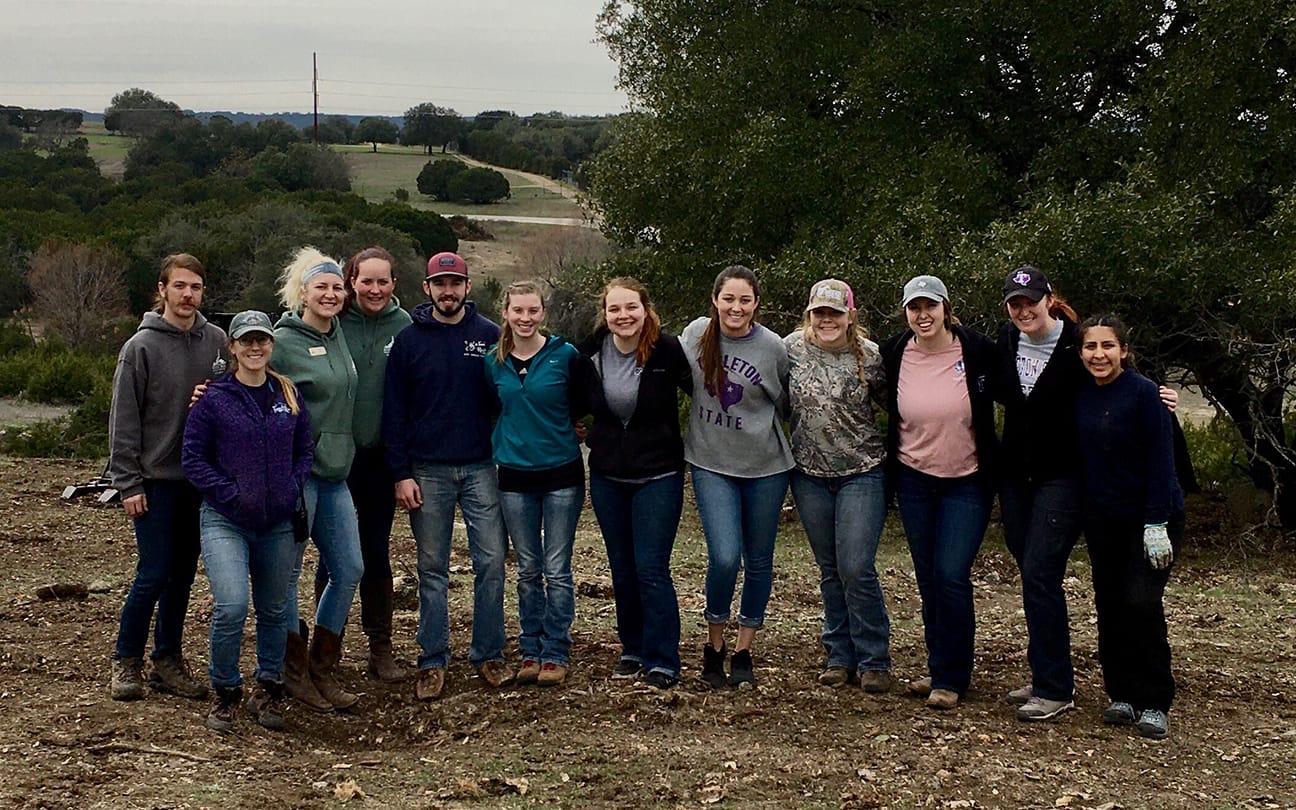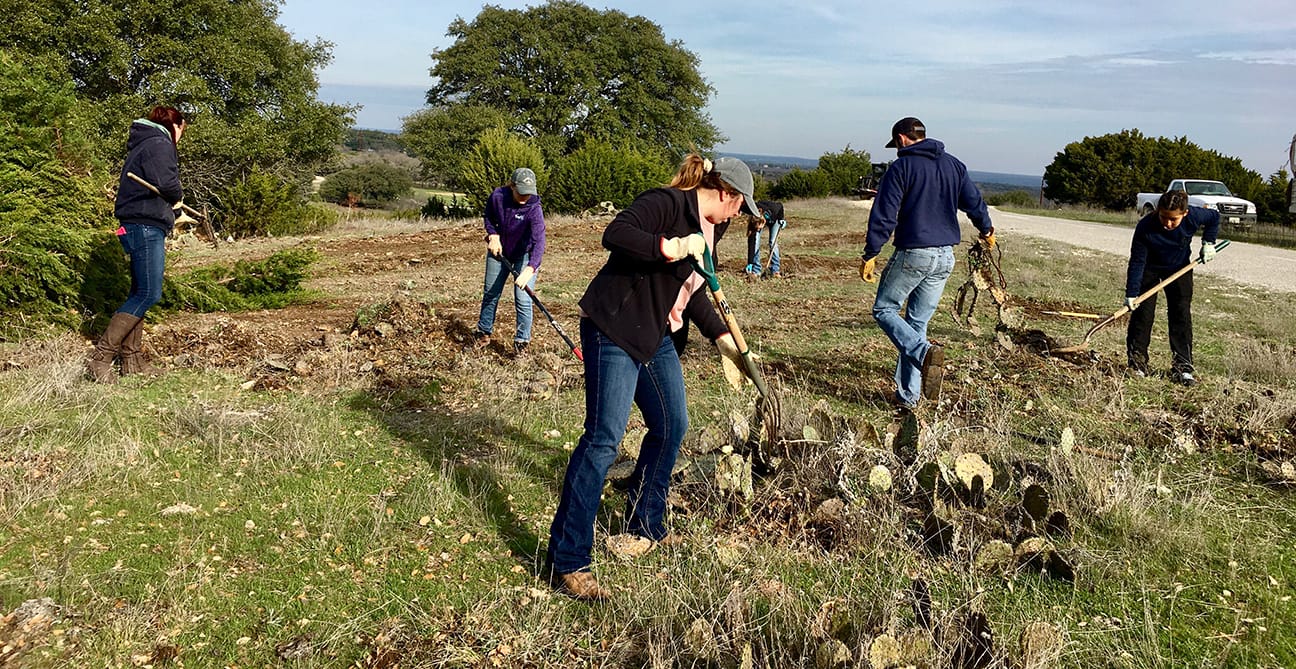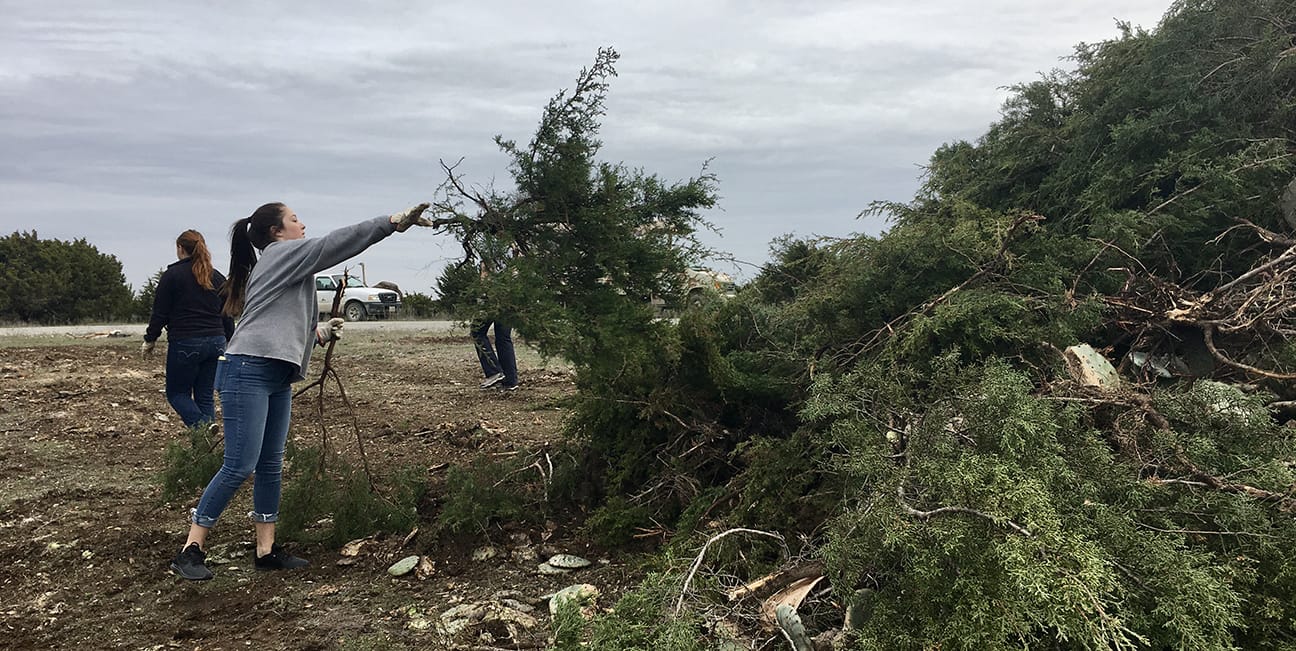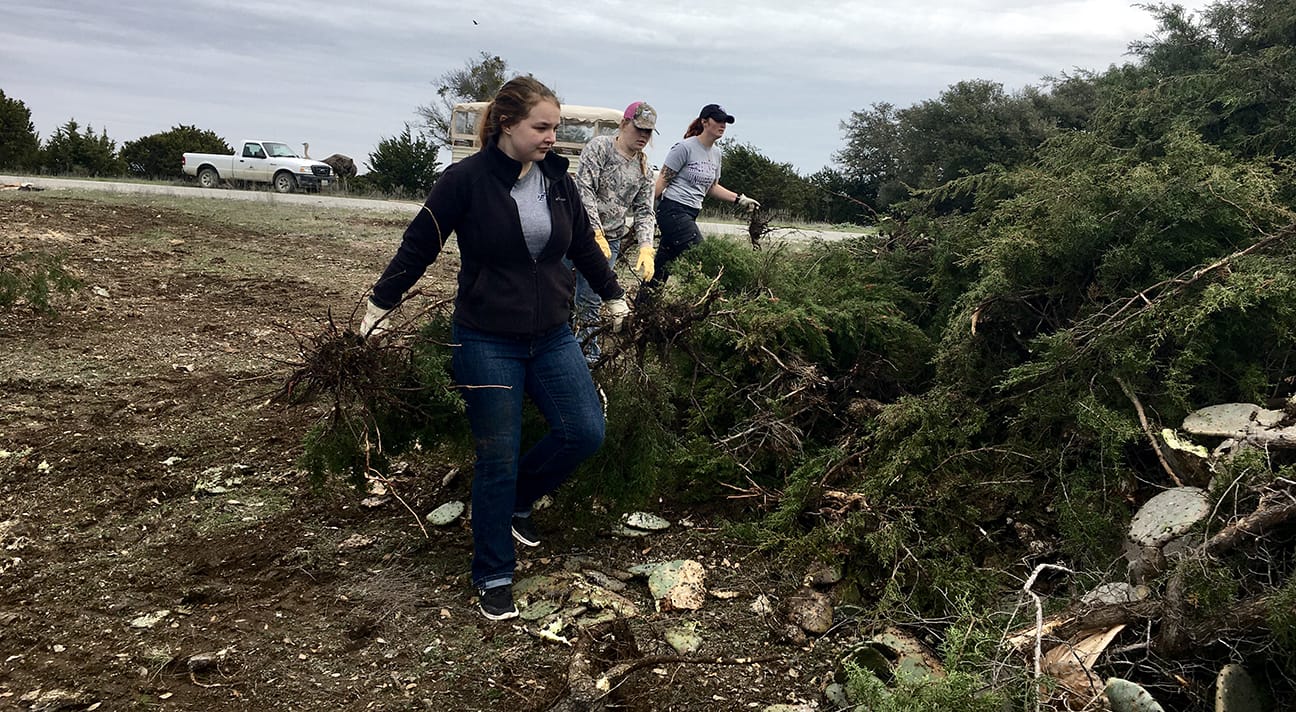Back in November, Fossil Rim staff got the ball rolling on the facility’s habitat restoration initiative of removing Ashe juniper trees with the help of Texas State Guard Engineers Regiment volunteers https://tinyurl.com/yx5solpe. The plant species has a significant root system that hogs water and overtakes large areas to limit growth of other plants, including grasses that our animals eat.

On February 22, students from Tarleton State University (TSU) Wildlife Society kept the momentum going by rejuvenating our Front Pasture through Ashe juniper removal. Natural Resources Manager Caitlin Pyle and Natural Resources Management Specialist Vanessa Hays were key to organizing both groups. Working with Volunteer Coordinator Will Baker, the continued progress has been a learning experience for all involved.
“As we’ve been able to host volunteer groups helping with juniper removal, with each one we’ve grown better and better in our process so that we are being more efficient when we’re out there,” said Baker. “With Caitlin, Vanessa, and (Director of Animal Care) Adam (Eyres) operating the heavy machinery, we wanted to maximize our volunteers on the ground. It’s definitely grunt work, but our Tarleton students were up to the task.”
Upon having the opportunity to assist the Texas State Guard Engineers Regiment volunteer group, one member of the TSU Wildlife Society identified juniper removal as a great way to make an impact with the wildlife center just a short drive to the east. Tarleton State junior Taylor Breeden reached out to Pyle and Baker to determine the possibility. It certainly helps that Breeden works as a Fossil Rim tour guide.
“After realizing how much I enjoyed helping with the Texas State Guard, I figured others in the same field as me would enjoy it, too,” explained Breeden. “So, I reached out to (TSU Wildlife Society) to see if there was interest before reaching out to (Pyle and Baker).”

Once the guests were on-site, the importance of hands-on learning was something that Breeden emphasized.
“Learning how to properly use the juniper grubbers was definitely something that you need to know going in, so that you don’t end up injuring yourself,” she said. “I did have really sore hands for the next two days, but at least my back and my legs weren’t getting thrown out because of improper use.”
Fossil Rim and Tarleton State University are no strangers. Separated by only 29 miles, the organizations have had a Memorandum of Understanding since 2013. Breeden was impassioned in explaining how the two organizations work together.
“There are a lot of connections between the two, especially when it comes to volunteering and ways of getting students out there to help,” she said. “Also, education is done by taking different groups from Tarleton, whether it be animal-related or not, and teaching them about the park and the planet. That’s where the biggest connection is: through education.”
Breeden was not the only Fossil Rim staff member present who has worn TSU purple.

“It was a great experience for Vanessa and me to be out there as Tarleton alums,” said Pyle. “Being able to educate these students and have them gain real-life experience on how environmental management plays a part in managing wildlife was energizing. As the TSU Wildlife Society, it’s important to see all different sides of that field, and this was a good example of that.”
Speaking of different sides of the field, the work really opened up some beautiful views. The group worked along the hill before the rhino enclosures, just to the left of the Gosdin Scenic Drive. From this vantage point, one can see much of the Front Pasture. Baker was pleased with how the removal opens up more of Fossil Rim’s landscape for drive-through guests.
“In addition to how great it is that the pasture is better for animals to be able to graze, the area we were working is right at a point where it’s very aesthetically pleasing looking over the pasture so you can see the pond and the wildebeest shed,” Baker said.
With the help of the TSU Wildlife Society, our animals now have more space to roam and more grass to graze. Animal care staff – Eyres, Rebecca McLachlan, and Ben Jernigan – helped to supervise the area and maintain safety in a pasture with approximately 200 animals. That included one highly interested ostrich.
“She was blocking the entrance to the vehicle that the volunteers were all trying to get onto, putting her wings down and flapping them, flapping her mouth open,” recalled Breeden. “She spent the whole morning pecking at her own reflection in the animal care truck.”

Even with a nosy neighbor, Hays was impressed with the students’ eagerness to soak in the experience.
“They were willing and wanting to ask questions about our profession, what we did, and how we got into it,” Hays said. “That was nice to be able to share and get them more interested in what we do.”
With a student volunteer group, the hope is that this type of workday leads to growth for all parties involved: our volunteers, our staff, our land, and our animals. Two days after the work, Pyle found the initial feedback promising.
“Just this morning, I saw a male blackbuck laying underneath one of those oak trees that we completely opened up…so that was pretty cool!” she said.
-Will Baker, Volunteer Coordinator

The Ashe Juniper is paramount in the life of the Endangered Golden Cheek warbler. Removing them is not a good conservation move. I loved seeing so many Ashe Junipers at Fossil Rim and thought I must be great habitat for the warblers. I am disappointed to read about this project.
Hello, our Natural Resources Manager Caitlin Pyle wanted to respond:
DeAnna,
We thank you for your appreciation of Ashe juniper trees and concerns for the loss of golden cheeked warbler habitat.
Fossil Rim is very conscientious of our Texas native species we have many acres of Fossil Rim that are maintained and protected solely for our native wildlife. During our juniper removal projects, we have kept the established old growth juniper as well as erosion control junipers. The junipers that are being removed from Fossil Rim are only in areas where they are in over abundance and out-competing other plants in our animal pastures. We have been focusing our efforts on the new growth trees that are out-competing our native hardwoods.
I can assure you when you come out to Fossil Rim again, you will still see plenty of Ashe juniper!